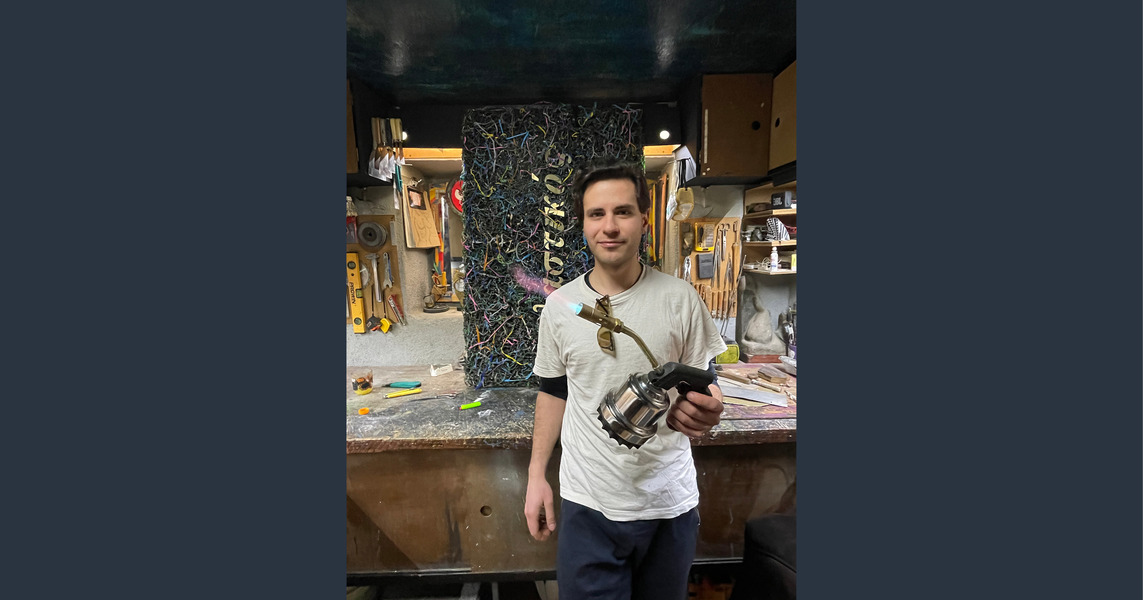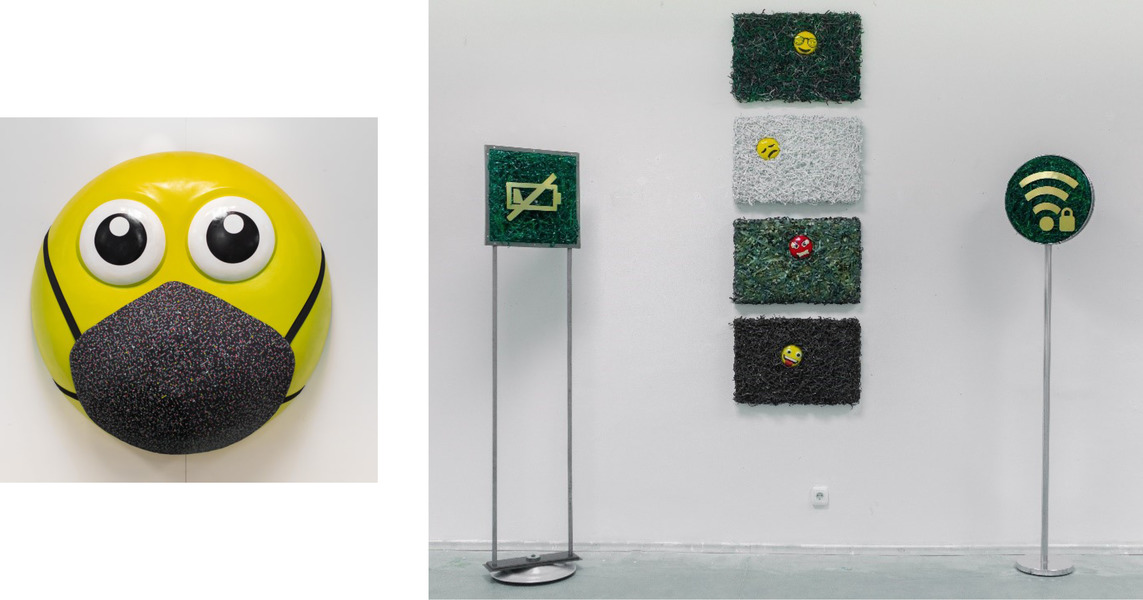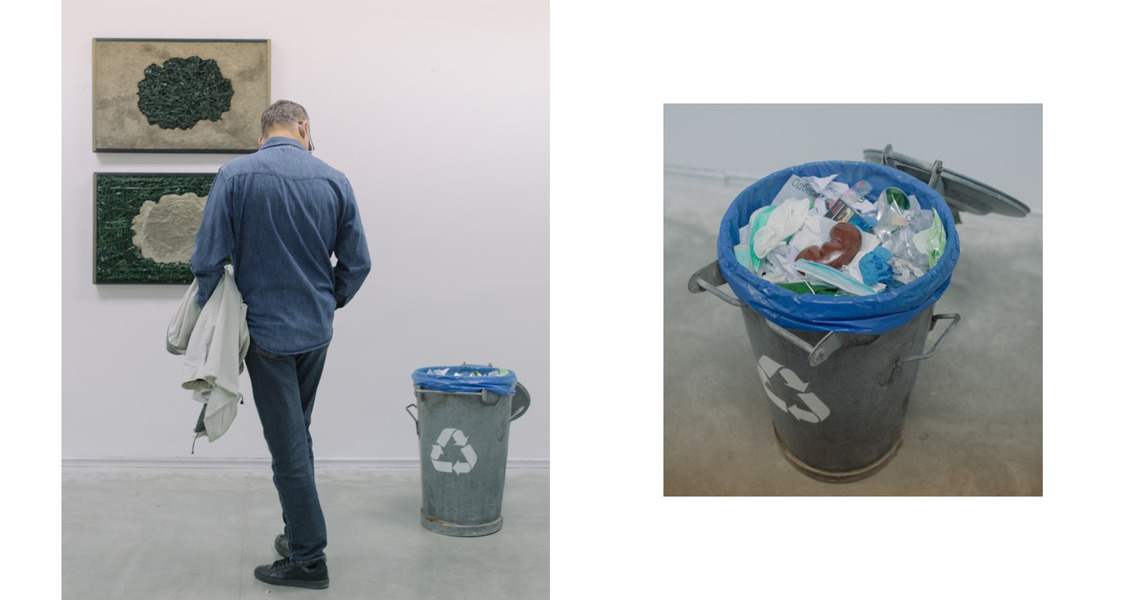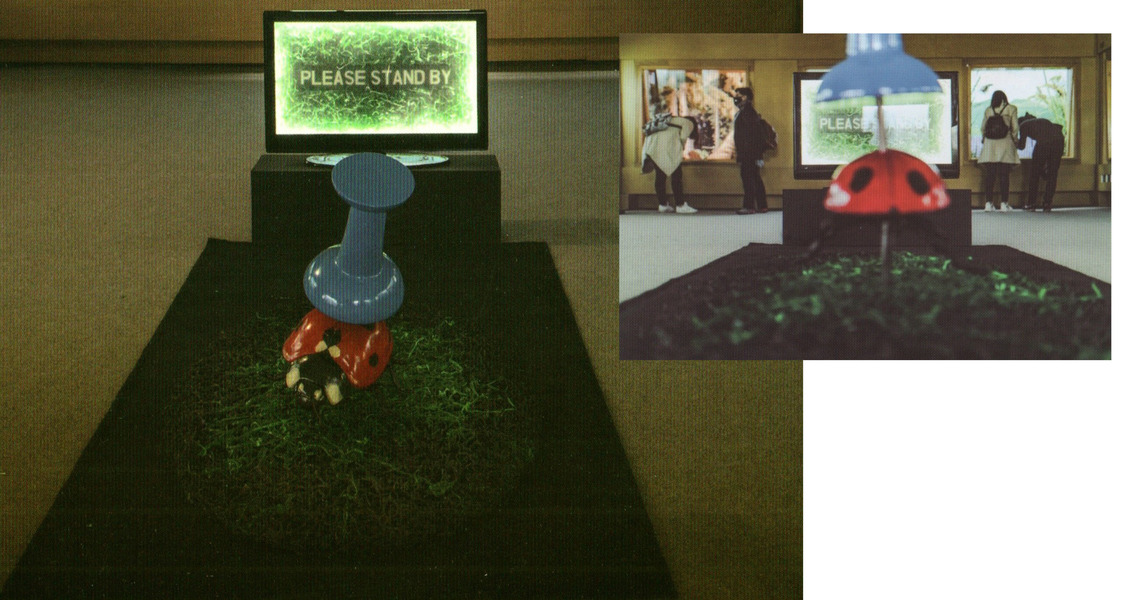Filip Ivanovski-Pepe talks about the material, the context, and the playful nature of his works
Published on 20.11.2022
The conversation was conducted in the spring of 2022 within the PrivatePrint Meets program and continued in November 2022 through electronic communication. Filip Ivanovski-Pepe (b. 1993 in Skopje) shares his views on his emerging artistic practice, contemporary art, the material at work, and the social challenges that are an incentive to seek a solution. He also talks about the experience of creating the exhibition Fear of Heights within the PrivatePrint VR Studio 2022.

You graduated from the sculpture department at the Faculty of Fine Arts; from your portfolio, you have worked in different media. What are your main mediums of expression?
I graduated in sculpture but never liked working in classical sculpture or portraiture. I do more installations and objects.
Your works explore and manipulate the material; one of the primary materials you work with is a used plastic bottle. Tell us more about this idea, how did it develop?
It has within it the idea of ecology. I collected thousands of plastic bottles. I was still a student when I started experimenting with some bottle shapes. At first, I was looking for cheap material. I’ve never wanted to buy new material; why should I buy and produce more garbage? There is always something that you can reuse. I was initially drawn to the color green. It is associated with grass and nature. And I liked that something that looks natural is artificial. I wanted a universal surface, field, and texture on which I could place multiple objects.

Filip Ivanovski-Pepe, "Civilization Process", "Tapestry" exhibition, FLU-Skopje, 2020
When I started experimenting with this material, the result seemed like it needed to be more mature at the time. I was cutting squares, and then I began cutting lines. I wanted to bring them to take some shape. They seemed unfinished, so raw, just intertwined like that. Something was missing, but I didn't know what. I wanted to break the linearity somehow. I spoke about this to Shumkovski at his studio and saw that he had a torch. I borrowed it from him, and when I first lit the plastic when it took shape, I knew that was that.
Your works are generally related to ecology and consumerism; you work with contemporary and current topics (such as the pandemic). What are you interested in thematically?
A long time ago, I realized there is no point in dealing with topics from the past, and contemporary art, in general, doesn’t need to deal with the past. I have always shown what is current, and the themes correspond to everyday life. If a revolution is happening today, the work should reflect it. I think there is a need when, for example, amid a pandemic, to express what is happening now. For example, I included the piece Emoticon as part of an exhibition that was postponed for two years [Tapestry exhibition, FLU-Skopje, 2020]; I was worried that the themes were already outdated, so I added that work because I wanted to give something from today.

Filip Ivanovski-Pepe, "Emoticon" and "Contemporary Language", "Tapestry" exhibition, FLU-Skopje, 2020
And what is your working method? What is your research process?
I don't research topics; I find a topic or technological achievement and try to present it differently. I start from an idea, something I've read, thought, whatever, and I want it to be fun to work with, the process to be enjoyable, and to actively involve me.
I have realized that an author's work should have a character, and that character should be close to their nature. I'm talking about it being recognizable. Let there be something individual. So I try to include my type of sarcasm in the works, my slightly more unusual sense of humor. I also want the pieces to be interesting - striking. Playful. I don’t usually convey a message directly. I want them to have a statement but leave room for metaphor, ask questions, generate conversation, and debate.

Filip Ivanovski-Pepe, "Coup d'état", "Tapestry" exhibition, FLU-Skopje, 2020
Do you have projects that you imagined but didn’t have the opportunity to realize?
I can think of five in a day. I like big, monumental projects because they are impressive. I get tired of the exhibition and gallery. I think more about works that don't have to be in a gallery. And they open up possibilities for larger sizes. If you can imagine it, you can do it because - you can. I don't believe in can't or in something unreal. That's my attitude towards life. I don't want to limit myself.
The next concept I'm working with, the latest thing I'm interested in, is the metaverse. I'm making an avatar from some metaverse or some hybrid. And I will walk that avatar around Skopje, photograph and record him doing everyday things, waiting in line at the bank, drinking beer in the park, going to the cinema and theater. And thus, through play, to point out some other topics. The sculpture itself isn’t the work but is a tool for creating the work and is itself a work. I'm working around these topics.
How does your work relate to technology, and what place does technology have in contemporary art?
I’m very interested in technology. Not because I'm much into technology, but it's making the most revolutions right now in the world.
Art and technology have always gone hand in hand. And starting from the fact that the work should be a child of modernity and be current, you have to collaborate with technology. A human can be imperfect, intentionally or unintentionally, but a robot can’t. And I think about which values will be respected in the future. Maybe in 300 years, people will be fed up with those monitors and digital works, and they may want to go somewhere to see how it used to be done. It would be interesting to think of the art being retro in the future, that it would have kept the old practices. However, I think it will always be a sign of what a human can do versus some robot.

Filip Ivanovski-Pepe, "Fear of heights", virtual exhibition, PrivatePrint VR Studio 2022
You worked with us as part of our virtual exhibition program, VR Studio 2022. In this context, how does the work on the exhibition Fear of Heights fit into your previous work?
Most of my work so far is down to current practices and content. Considering that, working on an exhibition in your virtual space is definitely in favor of my tendency to create works that are up to date with modern technologies and different forms of creating and presenting a specific concept.
The idea of VR Studio is to be a collaborative project. The exhibition is created between the artist, the designer, and the curator, and the works do not exist outside the virtual space. How do you see these possibilities of extraordinary cooperation?
To work on pieces that only exist in the virtual space is an opportunity to remove obstacles in the imagination and the performance of a certain idea. It is an opportunity for a different kind of collaboration where we can achieve a creative product through exchanging ideas and suggestions.

Filip Ivanovski-Pepe, "Empty walk", 13th Biennale of Young Artists of MoCA-Skopje, Natural History Museum of S. Macedonia, 2021
You are part of our art scene; how do you see it, and how do you see society's challenges, especially in culture and art?
I don't see the limitations in our society. On the one hand, it can be a challenge when we encounter social and political obstacles; on the other hand, it is really frustrating. Sometimes it is demotivating. No one is positive all the time. But it's good to have something, a sentence in your head that I will repeat to myself.
For example, "I don't want to be a product of my environment. I want my environment to be a product of me", from the film The Departed by Martin Scorsese [which can be read on the wall in his studio].
Some people are afraid and run away from problems, and I adore problems. The problem is an obstacle but also a theme to create a solution. Challenge.
The photographs of the works are courtesy of the artist.
--
PrivatePrintMeets is a series of meetings with emerging artists from N. Macedonia and is part of PrivatePrint's project activities funded by the Prince Claus Network Partnership programme.
VR Studio 2022 is co-financed by the Ministry of Culture of the Republic of North Macedonia and made possible through our activities in the PrivatePrint Meets series funded by the Prince Claus Network Partnership Programme.